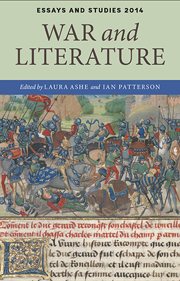Book contents
- Frontmatter
- Contents
- List of Illustrations
- Notes on Contributors
- Preface
- I IDEOLOGIES
- Acts of Vengeance, Acts of Love: Crusading Violence in the Twelfth Century
- Peril, Flight and the Sad Man: Medieval Theories of the Body in Battle
- ‘Is this War?’: British Fictions of Emergency in the Hot Cold War
- II INTERPRETATIONS
- III AFTERMATHS
- Index
Acts of Vengeance, Acts of Love: Crusading Violence in the Twelfth Century
from I - IDEOLOGIES
Published online by Cambridge University Press: 05 October 2014
- Frontmatter
- Contents
- List of Illustrations
- Notes on Contributors
- Preface
- I IDEOLOGIES
- Acts of Vengeance, Acts of Love: Crusading Violence in the Twelfth Century
- Peril, Flight and the Sad Man: Medieval Theories of the Body in Battle
- ‘Is this War?’: British Fictions of Emergency in the Hot Cold War
- II INTERPRETATIONS
- III AFTERMATHS
- Index
Summary
In october 1099, following the conquest of Jerusalem, First Crusade forces led by Duke Godfrey of Bouillon laid siege to the city of Arsuf, about fifteen miles north of modern Tel Aviv. According to the early-twelfth-century chronicler Albert of Aachen, the city's defenders attempted to distract Godfrey by crucifying one of Godfrey's men, Gerard of Avesnes. They placed him on the city walls within sight of the siege forces. Dying yet still able to talk, Gerard begged Godfrey to avenge his suffering and death. Godfrey told Gerard that, unfortunately, he could not avenge him; diverting men to do so would cost them the city. Furthermore, he added, ‘Certainly if you have to die, it is more useful that you alone should die than that our decree and be violated and this city remain always unsafe for pilgrims. For if you die to the present life, you will have life with Christ in heaven.’ With that Gerard was left to his fate, while the crusaders continued to assault the city.
The assault failed dramatically, prompting reflection on the potential causes of God's disfavour. In particular, Godfrey's response to Gerard's request for vengeance was called into question. Arnulf of Chocques, the newly appointed patriarch of Jerusalem, roundly condemned Godfrey not only for abandoning Gerard to his fate, but especially for failing to avenge his death. Arnulf described Godfrey's actions as ‘treachery and hardheartedness … impiety … base filth of all crimes’.
- Type
- Chapter
- Information
- War and Literature , pp. 3 - 20Publisher: Boydell & BrewerPrint publication year: 2014



